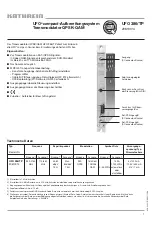
while the command line equivalent looks like this:
(
√
((a*x^2+b*x+c)/(
Σ
(1/k^2,k,1,
∞
)))+·(1/(sin(x))^2,x,
α
,
β
))^(
*Œ)
EQW has these features:
!
EQW is a no-stub ASM program.
!
Edit expressions, equations, matrices and lists.
!
Return expressions to the entry line, or to Lars Frederiksen's RPN program.
!
Evaluate expressions and define functions without leaving EQW.
!
Store and recall expressions
!
Cut, copy and paste and UNDO are supported, as well as forms for frequently-used expressions
!
Use function keys to factor, expand, collect, etc.
!
Scroll large expressions
!
Call EQW from your own TI Basic programs, and use dedicated [DIAMOND]-key functions
!
Write extensions to enhance EQW with toolbar menus, pop-up menus and other programs.
!
Only 24K bytes; can be archived.
!
Complete documentation with examples
Steve Chism has written a Windows application, TI Menus, which automates the process of creating
toolbar extensions for EQW. You can download TI Menus at http://www.warp2k.com/eqlib/tbmaker.htm
Nevin McChesney has written a sophisticated equation library program, Equation Library, which works
with EQW. For more information, see http://www.warp2k.com/eqlib/description.htm
[9.21] Programs for simple equation libraries
An equation library is a collection of equations together with a user interface to choose one of the
equations, then solve for one of the equation variables. The HP-48 series has a substantial built-in
library, and a similar library can be added to the HP-49G. The simple programs in this tip provide a
simple but similar equation library for the TI-89/92+. These library programs do not include graphics,
which are extremely helpful, and they cannot be used to solve multiple equations for a single variable.
Equation libraries are more useful for numeric solutions, not symbolic solutions. Once a symbolic
solution is found, it is not necessary to find the same variable again. However, multiple numeric
solutions may be required for equations in engineering and science applications. Therefore, the
equation library programs use the built-in numeric solver. Using the built-in solver simplifies the
programs, because the solver extracts the equation variables automatically. I also use the method of
tip [7.10] to automatically start the numeric solver after the equation is chosen. The built-in solver uses
9 - 25
Summary of Contents for TI-92+
Page 52: ...Component side of PCB GraphLink I O connector detail 1 41...
Page 53: ...LCD connector detail PCB switch side 1 42...
Page 54: ...Key pad sheet contact side Key pad sheet key side 1 43...
Page 55: ...Key cap detail 1 44...
Page 57: ...Component side of PCB with shield removed A detail view of the intergrated circuits 1 46...
Page 410: ...void extensionroutine2 void Credit to Bhuvanesh Bhatt 10 4...













































